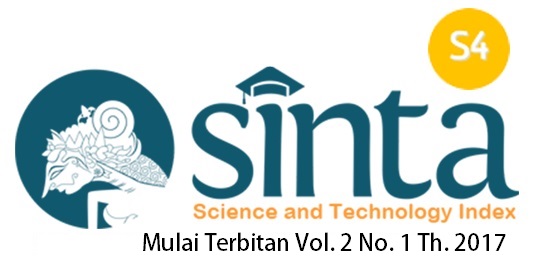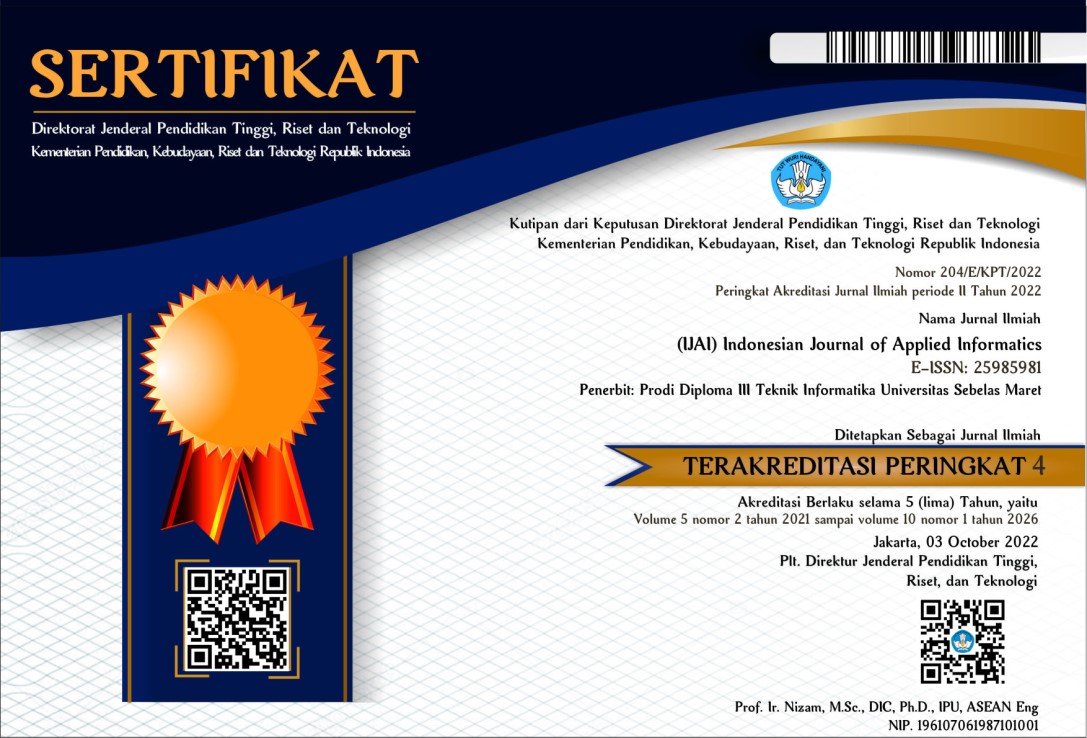Machine Learning Prediksi Karakter Pengguna Hastag (#) Bahasa Generasi Milenial Di Sosial Media
Abstract
Keywords
Full Text:
PDFReferences
P. K. L. Utama, “Identifikasi Hoax pada Media Sosial dengan Pendekatan Machine Learning”, Widya Duta Vol. 13, No. 1 2018, hal 69-76.
Purnomo, M, H, Sumpeno, S, Setiawan, E, I, Purwitasari, D, “Biomedical Engineering Research in the Social Network Analysis Era: Stance Classification for Analysis of Hoax Medical News in Social Media”, Procedia Computer Science 116 2017, pp. 3–9.
R, R, Sani,, J. Zeniarja, A. Luthfiarta, “Penerapan Algoritma K-Nearest Neighbor pada Information Retrieval dalam Penentuan Topik Referensi Tugas Akhir”, Journal of Applied Intelligent System, Vol. 1, No. 2, Juni 2016: 123 – 133.
S. M. Hutabarat, Anita Sindar, “Data Mining Penjualan Suku Cadang Sepeda Motor Menggunakan Algoritma K-Means”, Jurnal Nasional Komputasi dan Teknologi Informasi (JNKTI) 2 (2), 126-132.
M. Rivki, A. M. Bachtiar, “Implementasi Algoritma K-Nearest Neighbor Dalam Pengklasifikasian Follower Twitter Yang Menggunakan Bahasa Indonesia”, Jurnal Sistem Informasi (Journal of Information Systems), 2017, 31-37.
D. Simanjuntak, A. S. RM. Sinaga, “Sistem Pakar Deteksi Gizi Buruk Balita Dengan Metode Naïve Bayes Classifier”, Jurnal Inkofar * Volume 1 No. 2 Desember 2019, hl: 54-60.
Chairani, Widyawan, S. S. Kusumawardani, “Machine Learning Untuk Estimasi Posisi Objek Berbasis RSS Fingerprint Menggunakan IEEE 802.11g Pada Lantai 3 Gedung JTETI UGM”, Jurnal Infotel Vol. 7 No. 1 Mei 2015.
D. A. Ambarsari, R. N. Nurfalah, S. J. Kuryanti, “Penerapan Deep Learning dalam Pendeteksian Autism Toddler”, Infotekjar :Jurnal Nasional Informatikadanteknologijaringan- Vol. 4 No. 1, 2019.
F. Thabtah, “Autism spectrum disorder screening: Machine learning adaptation and DSM-5 fulfillment,” ACM Int. Conf. Proceeding Ser., vol. Part F129311, 2017, pp. 1–6.
Mustakim, G. Oktaviani, “Algoritma K-Nearest Neighbor Classification Sebagai Sistem Prediksi Predikat Prestasi Mahasiswa”, Jurnal Sains Teknologi dan Industri, Vol. 13, No.2, Juni 2016, pp.195 – 202.
A. S. RM. Sinaga, R. N. Zendrato, “Optimasi Penugasan Pegawai Menggunakan Metode Hungarian”, Journal of Innovation Information Technology and Application (JINITA), Volume 1 Issue 01 Pages 16-24 Tahun 2019.
Razzaghi, T., Roderick, O., Safro, I., Marko, N, Multilevel weighted support vector machine for classification on healthcare data with missing values. PloS ONE, 11(5), e0155,119.P. K. L. Utama. 2018. Identifikasi Hoax pada Media Sosial dengan Pendekatan Machine Learning”, Widya Duta Vol. 13, No. 1. hal 69-76.
. Ramadhan, R. S. Junta, Z., Ardytha, L. 2016. Penerapan Algoritma K-Nearest Neighbor pada Information Retrieval dalam Penentuan Topik Referensi Tugas Akhir. Journal of Applied Intelligent System, Vol. 1, No. 2, 123 – 133.
Refbacks
- There are currently no refbacks.






